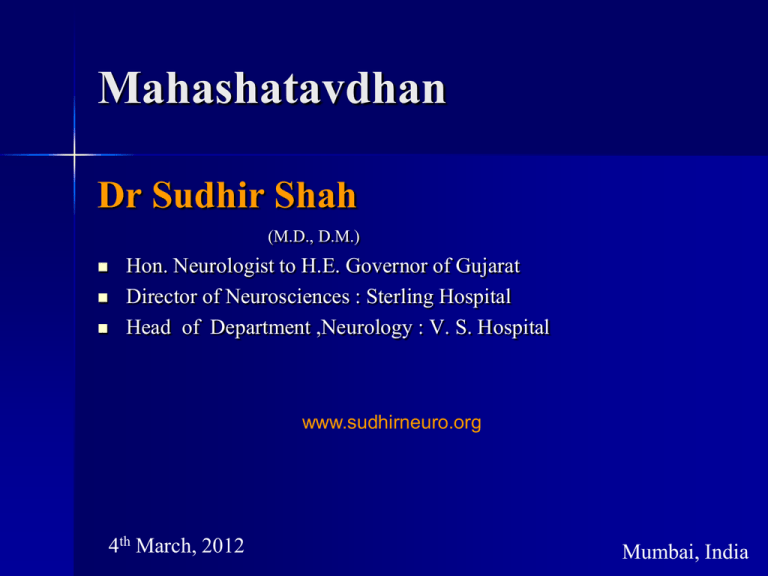shatavadhani - Dr. Sudhir V. Shah
advertisement

Mahashatavdhan Dr Sudhir Shah (M.D., D.M.) Hon. Neurologist to H.E. Governor of Gujarat Director of Neurosciences : Sterling Hospital Head of Department ,Neurology : V. S. Hospital www.sudhirneuro.org 4th March, 2012 Mumbai, India Towards Powerful Cognition Plan of My Talk Memory function Tips to improve memory Jain view Human Brain Capacity Human brain has roughly 100 billion (1011) neurons and 100 trillion (1014) synapses One can store enormous facts e.g. 90 million books each having 1000 pages One can hold approximately seven items in short-term memory for about 20 to 30 seconds It is known that we severely underutilize our brain Brain VS Computer The brain is much, much bigger than any [current] computer Accurate biological models of the brain would have to include some 225,000,000,000,000,000 (225 million billion) interactions between cell types, neurotransmitters, Neuro modulators, axonal branches and dendritic spines No hardware/software distinction can be made with respect to the brain or mind Brains are analogue; computers are digital Brain VS Computer The brain is a massively parallel machine; computers are modular and serial Processing speed is not fixed in the brain; Short-term memory is not like RAM Synapses are far more complex than electrical logic gates Unlike computers, processing and memory are performed by the same components in the brain The brain is a self-organizing system What is Memory? Memory is a specific cognitive function: the storage and retrieval of information As such, it is the prerequisite for learning, the building block of all human knowledge Limbic System & Memory Certain structures of the limbic system are involved in memory function These large limbic system structures AMYGDALA and HIPPOCAMPUS are Limbic System The Hippocmapus The Hippocampus Plays an important role in consolidating information from short-term memory into long-term memory and retrieves them when necessary The Amygdala The Amygdala is responsible for determining what memories are stored and where the memories are stored in brain & responsible for emotional memories Cohen and Squire, 1980 Memory Declarative Non-declarative Available to conscious retrieval Experience-induced change in behaviour Can be declared (propositional) Cannot be declared (procedural) Examples “What did I eat for breakfast?” (episodic) “What is the capital of Spain?” (semantic) “What did I just say?” (working) Examples Subliminal advertising (priming) How to ride a bicycle? (skills) Phobias (conditioning) Mati Gyan + Shrut Gyan What Is Working Memory ? A combination of – Attention – Concentration – Short-term memory The ability to temporarily manipulate information maintain and Working Memory The Prefrontal Cortex With more difficult tasks involving bilateral brain activation The number of activated brain regions in the prefrontal cortex increases as the complexity of the task increases. In Munishri, the prefrontal cortex, hippocampus & amygdala must have been very well developed….. Hypothesized Memory Processes: Encoding, Consolidation, and Retrieval Encoding, Consolidation and Retrieval of Declarative Memories Shatavadhani Shrimad Rajchandra (1867-1901) Shatavadhani Dr.R.Ganesh ( 1981) Muni Mahendra Kumar (1957) Sathavathani Sheikh Thambi Pavalar (18741950) Shri Manek Muniji Maharaj (1991) Shatavadhan And Above Dr. Garikipati Narasimha Rao (2002) Dr. Medasani Mohan (1996) Dr. Nagaphani Sarma (2000) Kadimalla Varaprasad Yashodevsuri Ma. Saheb Dharmsuri Ma. Saheb Nirmalashriji Munishri Ajitchandrasagarji Maharaj ( D/O Panyasshree Naychandra Sagarji Maharaj) Scientific Tips For Higher Cognition Repetition Symbolization Association Visualisation Remove stress Neurobics Be Positive Be Interested Be Attentive Be Active Be Relaxed & Happy Be yourself Limitations of Scientific Knowledge Laws of Conservation defined only for physical systems which are closed and passive Biological systems are open systems Constantly interacting with the environment Human beings have memory, which makes it difficult to do any scientific experiment on them Jain view Gyanavarniyakarma xayopasham Worship of Gyan, Gyani & tools of Gyan. Linked with Past birth achievements Ways shown to lead to kevalgyana Jain (Oriental-Spiritual) View to Achieve Higher Cognition Maun (silence) Brahamcharya (celibacy) Sadhna (austerity) Tapasya (penance) Pratyahaar ( Control of Senses) Vinay (politeness) Mantrajap (chanting) Swadhyaya (spiritual reading) Constant Abhyas ( Repeatition) Dhyana (Meditation) Spiritual Order and Shatavadhanies Shatavdhanies’ spiritual practices involve all these disciplines By these mind goes into low entropy state & tremendous data can be stored and recalled efficiently Involves parapsychology like telepathy and clairvoyance It will provide new direction of evolution which is very different from Darwin’s principle of evolution It is a big challenge for the modern science Shri Pokharna Jain’s Theory of Knowledge Through Consciousness As per modern science, knowledge is nothing but information organized in some way and information is nothing but data organized in some way We can collect data and generate information and knowledge through consciousness So all knowledge is structured in the consciousness Hence the Jain concept that knowledge is structured in the consciousness is very logical, as demonstrated by shatavadhanies However final destination is Kevalgyan Role of Subconscious Mind Subconscious Mind The subconscious (preconscious) mind is part of the conscious mind and includes our memory. These memories are not conscious, but we can retrieve them to conscious awareness at any time Your subconscious mind remembers everything even those things that have entirely by-passed your conscious awareness So boosting Subconscious mind can be powerful memory tool…..by spiritual practices like meditation, silence, etc. Suggested Hypothesis There may be opening of Millions of Synapses Increased function of Neurotransmitters More use of Association areas Role of Prefrontal cortex, as it is more developed in animals with higher intelligence Formation of G Module and extraordinary tracks of neurons Development of new storage areas Memory and Gene Neuroscientists identified a master controller of memory Npas4 gene appears to regulate the brain’s ability to form new memories So by increasing this Gene Expression one can make powerful memory Genes Molecules Synapses Neurons systems Networks Behaviour "We remember what we understand; we understand only what we pay attention to; we pay attention to what we want" - Edward Bolles The Value of Chunking You have 5 seconds to memorize as much as you can Then, draw an empty chess board and reproduce the arrangement of pieces Thank you











